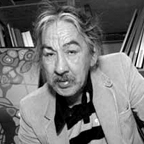
Norval Morrisseau, Ojibway,
1931-2007
He was a self-taught artist of Ojibwa ancestry (his Ojibwa name,
which appears in syllabics on his paintings, means “Copper
Thunderbird”) and he originated the pictographic style,
or what is referred to as “Woodland Indian art”, “legend
painting” or “x-ray art.” This style is a fusion
of European easel painting with Ojibwa Midewiwin Society scrolls
and pictography of rock paintings. Introduced to the Canadian
public at the Pollock Gallery, Toronto, in 1962, Morrisseau was
the first artist of First Nations ancestry to break through the
Canadian professional white-art barrier. Throughout the 1960s
Morrisseau's pictographic style grew in popularity and was often
perceived by other Cree, Ojibwa and Ottawa artists as a tribal
style, to be adapted for their own cultural needs. By the 1970s
younger artists painted exclusively in his genre. For Morrisseau,
the 1970s were a time of struggle to reconcile traditional Midewiwin
and Christian religions in his art and personal life. Combining
his Ojibwa heritage, instilled in him by his maternal grandfather,
Moses Nanakonagos, with the religion Eckankar, his works during
the 1980s became more focused on spiritual elements. Morrisseau
studied Ojibwa shamanistic practices, which he believed elevated
his work to a higher plane of understanding. Norval Morrisseau
was presented with the Order of Canada in 1978. In 2006, the National
Gallery of Canada mounted Norval Morrisseau - Shaman Artist, a
travelling retrospective exhibition of the artist's work.